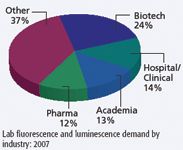Market Profile: Luminometers
Although the market for dedicated single-tube luminometers now pales in comparison to multimode fluorometers and microplate readers, such luminometers continue to satisfy a niche market. The relative simplicity and therefore low cost is their major advantage, which is appealing to smaller life science laboratories.
Market Profile: Luminometers
Although the market for dedicated single-tube luminometers now pales in comparison to multimode fluorometers and microplate readers, such luminometers continue to satisfy a niche market. The relative simplicity and therefore low cost is their major advantage, which is appealing to smaller life science laboratories.
Most modern fluorescence spectrophotometers are capable of performing luminescence analyses as well, while fluorescence is the most common method used among microplate readers. Both types of instruments now account for the vast majority of demand from scientists who require the ability to perform luminescence measurements, including chemiluminescence and bioluminescence. However, conventional single-tube luminometers are very simple instruments, and typically cost around $5,000, whereas spectrofluorometers and microplate readers can easily cost four to five times as much.

Lab fluorescence and luminescence demand by industry: 2007
Luminometers are used most heavily for biological analyses, with the largest demand coming from biotechnology, clinical, and academic biology laboratories. They are most appealing to smaller laboratories and educational laboratories, where throughput requirements are much lower and cost is far more of an issue.
The global market for single-tube luminometers in 2007 was more than $15 million. Despite heavy competition from microplate readers and fluorescence spectrophotometers, luminometer demand should see low single-digit growth going forward.
The foregoing data were based upon SDi's market analysis and perspectives report entitled Edition Global Assessment Report, 10th Edition: The Laboratory Life Science and Analytical Instrument Industry, September 2008. For more information, contact Stuart Press, Vice President – Strategic Analysis, Strategic Directions International, Inc., 6242 Westchester Parkway, Suite 100, Los Angeles, CA 90045, (310) 641-4982, fax: (310) 641-8851, www.strategic-directions.com.

New Fluorescence Model Enhances Aflatoxin Detection in Vegetable Oils
March 12th 2025A research team from Nanjing University of Finance and Economics has developed a new analytical model using fluorescence spectroscopy and neural networks to improve the detection of aflatoxin B1 (AFB1) in vegetable oils. The model effectively restores AFB1’s intrinsic fluorescence by accounting for absorption and scattering interferences from oil matrices, enhancing the accuracy and efficiency for food safety testing.
Tracking Molecular Transport in Chromatographic Particles with Single-Molecule Fluorescence Imaging
May 18th 2012An interview with Justin Cooper, winner of a 2011 FACSS Innovation Award. Part of a new podcast series presented in collaboration with the Federation of Analytical Chemistry and Spectroscopy Societies (FACSS), in connection with SciX 2012 ? the Great Scientific Exchange, the North American conference (39th Annual) of FACSS.
New Fluorescent Raman Technique Enhances Detection of Microplastics in Seawater
November 19th 2024A novel method using fluorescence labeling and differential Raman spectroscopy claims to offer a more efficient, accurate approach to detect microplastics in seawater. Developed by researchers at the Ocean University of China, this method improves both the speed and precision of microplastic identification, addressing a key environmental issue affecting marine ecosystems.